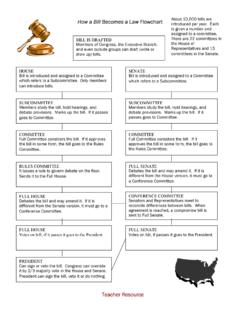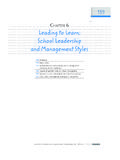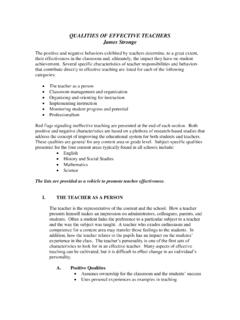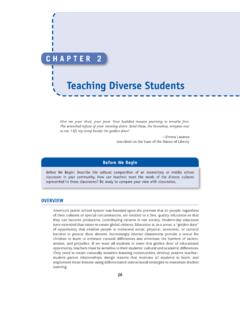Transcription of What is Differentiated Instruction? Examples of How to ...
1 Is Differentiated Instruction? Examples of How toDifferentiate Instruction in the ClassroomPosted October 1, 2014 by Cathy Weselby in Teaching StrategiesJust as everyone has a unique fingerprint, each student has anindividual style of learning. Not all students in a classroom learna subject in the same way or share the same level of instruction is a method of designing and deliveringinstruction to best reach each Ann Tomlinson is a leader in the area of differentiatedlearning and professor of educational leadership , foundationsand policy at the University of Virginia. Tomlinson describesdifferentiated instruction as factoring students individual learningstyles and levels of readiness first before designing a lessonplan.
2 Research on the effectiveness of differentiation shows thismethod benefits a wide range of students, from those with learning disabilities to those who are considered instruction may mean teaching the same material to all students using a variety of instructionalstrategies, or it may require the teacher to deliver lessons at varying levels of difficulty based on the ability of eachstudent. Formative assessment is an essential ingredient of this who practice differentiation in the classroom may:Design lessons based on students learning students by shared interest, topic or ability for students learning using formative the classroom to create a safe and supportive assess and adjust lesson content to meet students of Differentiated instructionThe roots of Differentiated instruction go all the way back to the days of the one-room schoolhouse, where oneteacher had students of all ages in one classroom .
3 As the educational system transitioned to grading schools, it wasassumed that children of the same age learned similarly. However in 1912, achievement tests were introduced, andthe scores revealed the gaps in student s abilities within grade 1975, Congress passed the Individuals with Disabilities Education Act (IDEA), ensuring that children withdisabilities had equal access to public education. Educators used Differentiated instruction strategies to reach thisstudent population. The passage of No Child Left Behind in 2000 further encouraged Differentiated and to differentiate instructionIt makes sense to provide different avenues of learning for students to reach the same destination. Research byeducator Leslie Owen Wilson supports differentiating instruction within the classroom .
4 Wilson found lecture is theleast effective instructional strategy, with only 5 to 10 percent retention after 24 hours. Engaging in a discussion,practicing after exposure to content and teaching others are much more effective ways to ensure learning to Tomlinson, teachers can differentiate instruction through four ways: 1) content, 2) process, 3) product,and 4) learning ContentFundamental lesson content should cover the standards of learning set by the school district or state educationalstandards. Some students in a class may be completely unfamiliar with the concepts in a lesson, some students mayhave partial mastery, and some students may already be familiar with the content before the lesson teacher may differentiate the content by designing activities for groups of students that cover various levelsof Bloom s Taxonomy (a classification of levels of intellectual behavior going from lower-order thinking skills to higher-order thinking skills).
5 The six levels are: remembering, understanding, applying, analyzing, evaluating and who are unfamiliar with a lesson may be required to complete tasks on the lower levels: remembering andunderstanding. Students with some mastery may be asked to apply and analyze the content, and students who havehigh levels of mastery may be asked to complete tasks in the areas of evaluating and of differentiating activities:Match vocabulary words to a passage of text and answer related of a situation that happened to a character in the story and a different fact from opinion in the an author s position and provide evidence to support this a PowerPoint presentation summarizing the ProcessEach student has a preferred learning style, and successful differentiation includes delivering the material to eachstyle: visual, auditory and kinesthetic and through words.
6 Not all students require the same amount of support fromthe teacher, and students could choose to work in pairs, small groups or individually. While some students maybenefit from one-on-one interaction with a teacher or classroom aide, others may be able to progress by can enhance student learning by offering support based on individual of differentiating the process:Provide textbooks for visual and word auditory learners to listen to audio kinesthetic learners the opportunity to complete an interactive assignment ProductThe product is what the student creates at the end of the lesson to demonstrate the mastery of the content. This canbe in the form of tests, projects, reports or other activities.
7 Teachers may assign students to complete activities thatshow mastery of an educational concept in a way the student prefers, based on learning of differentiating the end product:Read and write learners write a book learners create a graphic organizer of the learners give an oral learners build a diorama illustrating the Learning environmentThe conditions for optimal learning include both physical and psychological elements. A flexible classroom layout iskey, incorporating various types of furniture and arrangements to support both individual and group speaking, teachers should use classroom management techniques that support a safe andsupportive learning of differentiating the environment.
8 Break some students into reading groups to discuss the students to read individually if shows Differentiated instruction is effective for high-ability students as well as students with mild tosevere students are given more options on how they can learn material, they take on more responsibility fortheir own appear to be more engaged in learning, and there are reportedly fewer discipline problems inclassrooms where teachers provide Differentiated instruction requires more work during lesson planning, and many teachers struggle to find theextra time in their learning curve can be steep and some schools lack professional development and cons of Differentiated instructionProsResearch shows Differentiated instruction is effective for high-ability students as well as students with mild tosevere students are given more options on how they can learn material, they take on more responsibility fortheir own appear to be more engaged in learning, and there are reportedly fewer discipline problems inclassrooms where teachers provide Differentiated instruction requires more work during lesson planning.
9 And many teachers struggle to find theextra time in their learning curve can be steep and some schools lack professional development argue there isn t enough research to support the benefits of Differentiated instruction outweighing theadded prep : Engaging Activities / leadership and Administration / Mid-Career Teacher / New Teacher / Veteran Teacher 2015 Concordia Online Education 2015 Concordia Online Educatio






